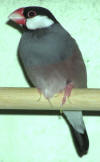. Java finch

Aviary Notes: Read notes on "Finches - Non Australian" web page and use in conjunction with details outlined on this page. Level Of Knowledge Required: Beginner / Intermediate / Advanced / Specialist Breeders Only. Government Regulations & By-Laws: Refer to "Government Laws" web page. Housing Requirements: Click on "Housing birds" web page for general details on the housing of Non Australian Finches or read on for specific details for this finch. The seem perfectly happy in a parrot style aviary devoid of plants or shrubs. Java finches will quickly de-leaf a shrub or leafy plant. They are active birds in an aviary and the provision of branches at both ends of the aviary will allow them to exercise their flight skills and keep fit. Can be bred indoors in a budgie / canary breeder size cage as well as an outdoor aviary. Can be housed as a colony in a suitably sized aviary. They can be bred in a Canary style breeder cage of about 900mm long x 400mm high x 400mm deep (36 x 16 x 16 inches). Only one breeding pair per cage. Diet / Feeding: Click on "Feeding birds" web page for general details on the nutrition of Non Australian Finches or read on for specific details for this finch. One of the easiest species of birds to feed. They require a good quality finch mix and some seeding grasses to produce a successful clutch. They will eat some fruits (e.g. apple) and vegetables. Live foods are not essential for successful breeding of Java finches but will be beneficial and provide a more balanced protein diet. Mealworms are commonly used. Basic seed mix should include Canary seed, White French Millet, Japanese Millet, and Yellow and Red Panicum. Nesting: A basic overview only.
In a colony, nests should be well separated to minimize the potential for aggression. More details on finch nests and a selection of finch nest photos can be located on the "nests", "finch nests" and "finch nest photos" web pages. Click on "Up" then "nests" then "finch nests" and "finch nests photos" in the navigation bars. Breeding: Egg Colour White. Clutch/s per year 3. Eggs per nest 4 - 7. Incubation approx. 14 days. Fledge approx. 28 days. Independent approx. another 4 weeks. Parents are generally tolerant of nest inspections and generally allow the owners to leg ring the young. Java young are in the nest for a longer duration of time than other species of finches and emerge as a large bird with good ability to fly. The young will return to the nest at night. Generally safe to leave the young in the aviary after the parent birds start another clutch. If young are left in the aviary with the parent birds care has to be taken to avoid the possibility of overcrowding. Javas are often prolific breeders. Pair bonds are not strong and re-pairing is easy and quick. Can be bred in cages to produce a particular coloured young and to more easily know the genetic background of each bird. Young birds (when they become fully independent) must be removed when bred in a cage. Generally safe to remove the young from the parent birds 4 weeks after they have left the nest. Artificial incubation, hand rearing or fostering will not be covered on this web site. It is too complex and diverse in nature to be attempted here. Refer "Specific References" as listed below and "General References" listings. Health Issues: Refer "Avian Health Issues" web page for information and references.
General References: Refer to references listed on "Book References" web page. Specific References:
|